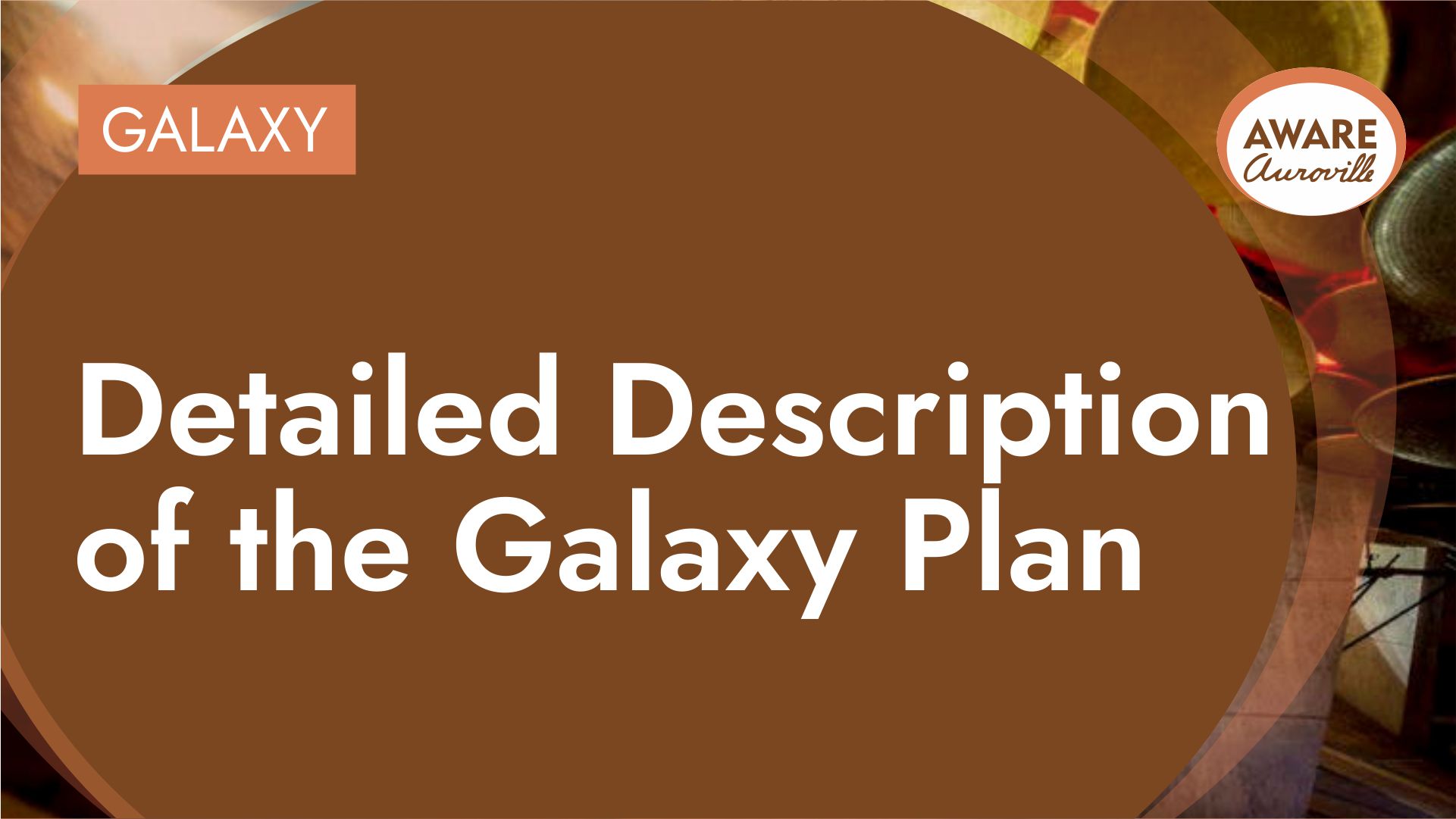
1969 ca
I – THE DATA OF THE PROBLEM
INTRODUCTION
Auroville is a unique town. It will receive people who, from different parts of the world, will come with the determination to live together in an atmosphere of harmony and mutual understanding. Traditional social and human relations will have no place there. Competition and struggle will give place to emulation, collaboration and brotherhood.
This shows how inadequate are the standard techniques and the vocabulary of Town planning. But this inadequacy should not exempt us from carrying out a research on the leading principles of organisation and working of the urban space. The philosophical and humanitarian purpose, as well as the will to fit the architecture to the framework of life is confronted with demographic, economic, technical and financial exigencies of all such endeavours.
1- GEOGRAPHICAL CONDITIONS
– The town is implanted at a distance of 8 kilometres from Pondicherry, on the South-East coast of the Indian continent. Auroville has the benefit of being only 5 kilometres from the sea.
– It has a tropical climate. The dry season usually lasts for a period of 7 months, from January to July, May and June are the hottest periods with occasional showers. The rainy season is mainly from October to January. The average rainfall is 970 mm a year.
The prevailing wind blows from the South-East.
– The site chosen was a barren plateau, comparatively flat, overlooking the sea where an ancient Banyan tree indicates the centre of the new town. The plateau is 50 metres above sea-level.
– The present population is grouped in villages, mainly localised towards the sea. A few widely separated villages surround the area under consideration.
The way of life of the local population is very traditional still.
2- FUNCTIONS OF THE TOWN AND ITS POPULATION
a- Functions:
Cultural:
There are no other words to render an account of the totality –and of the wealth- of Spiritual and educational activities, quest and encounter. The principle function of the town is to promote a new culture by creating a novel urban civilization.
Relations with the world: Auroville is a place where nations and civilizations will meet; problems of universal interest will be studied here. The town will contribute to the formation of a body of international people.
Education and teaching: In this field is the essential task of the town, it has to promote the enrichment of the body and the mind.
Research: Auroville will gather a group of research-workers to study experimentally and spiritually the question of human unity.
Economy:
The economical activity is the material support of the life and radiation of Auroville. It will contribute to the expression of cultural activities (cinema, industry and technical teaching). Without being considered a regional pole of growth, the town has to contribute to the local development by offering industrial employment to the local population and by giving them a technical education.
b- Population:
At its final stage of stability, Auroville will have 50,000 citizens. This population should permit a harmonious functioning of the town. This number has been fixed from the outset.
Age groups:
The town will be people by immigration. Examples of new towns show us that in such town the population has a relatively small proportion of people below the age of 20 and above 60. This tendency is stronger in Auroville because of its peculiar characteristics. The immigration on the average will be the result of a decision, hypothetically, taken by the adult youth.
The distribution of the population according to large age-groups could be as follows: one third of the inhabitants below 20 years, one tenth above 60 and more than half between 20 to 60 years of age.
Proposed distribution:
0 to 19 years: 17000
20 to 59 years: 28000
60 and above: 5000
Working Population:
The population in the working age is represented by the block of 20 to 59 years, i.e. 28000 persons.
The working population having an employment (in the normal economic sense) corresponds to the population of the working age to which is to be added those above 60 pursuing some activity (2000) and from which has to be subtracted those above 20, who are students and probationers (2000) that is: 28000 persons.
Distribution of the working population according to the kind of activity:
This distribution should enable the town to fill all activities it has in view:
Principle of distribution Percentage Total number
Production of goods 30 % 8400
Farming 5 1400
Industry 15 4200
Cottage industry 10 2800
Services 45 12600
Economic block 20 5600
Collective service 19 5500
Administration 6 1500
Cultural Activities 25 7000
Educationist 15 4200
Research workers 10 2800
Total 100 28000
3- ARCHITECTURAL PROPOSALS WITH A VIEW TO A SUITABLE FRAME WORK OF LIFE
a- Areas and general zoning:
Zone Area in Ha % Remarks
Residential 153 30.0 Made up of neighbourhoods and wards.
Cultural 72 14.1 University and research complex
Economic 94 18.3 Services and production of goods
International 81 15.9 National Pavilions and University of Peace
Administration 9 1.7 Having municipal offices
Green spaces 102 20.0 Matrimandir complex: 30 Ha; recreation
Total 510 100.0
b- The architects propose to establish a frame-work of living in accordance to the cultural aspirations of the future citizens. The architecture realises at first a synthesis between the cultural exigencies and the climatic conditions.
Importance of the green spaces.
Vertical buildings allowing an optimum utilisation of the prevailing winds.
Mechanical urban traffic limited to the needs of collective movement.
Public means of transport for persons and goods.
Importance of covered roads for pedestrians.
Community – organisation of the way of living.
The town converging on the garden of meditation.
Research for low utilisation of constructed space.
HOUSING
1- TYPES AND PRINCIPLE HYPOTHESIS
a- Vertical Collective housing
An increasing number of levels from the centre of the town to the periphery, for the totality of houses, an average number of levels will be adopted (ex: building 1: 18 levels at the highest part, average number of levels: 9)
The volume determined by the surface of the acquired land and the average number of levels is composed of occupied spaces and empty spaces; its utilisation is not total, it corresponds to 65 % of the total volume (coefficient of utilisation: 0.65%).
For a better stability of all the vertical collective residences the distribution of the useful area is as follows:
60% cells and 40% flats.
The cell has 30 m2 for private use and 10 m2 for collective use.
Five cells can shelter six persons.
The flat has 75 m2 for private house, and 25 m2 for collective use. On the average a flat can shelter 2 adults and 2 children (4 inhabitants per flat).
Capacity of absorption
| (0) | (1) | (2) | (3) | (4) | (5) | (6) | (7) | (8) | (9) |
| 1 | 42000 | 9 | 0.65 | 245700 | Cells: 3685 Flats: 1092 | 4422 4368 | 4422 2184 | 2184 | 8790 |
| 2 | 8000 | 9 | 0.65 | 46800 | Cells: 702 Flats: 208 | 842 832 | 842 416 | 416 | 1674 |
| 3 | 5500 | 8 | 0.65 | 28600 | Cells: 429 Flats: 127 | 515 498 | 515 249 | 249 | 1013 |
| 4 | 21000 | 8 | 0.65 | 109200 | Cells: 1638 Flats: 485 | 1965 970 | 1965 970 | 970 | 3905 |
| 5 | 5500 | 8 | 0.65 | 28600 | Cells: 429 Flats: 127 | 515 249 | 515 249 | 249 | 1013 |
| 6 | 13000 | 8 | 0.65 | 67600 | Cells: 1014 Flats: 300 | 1217 1200 | 1217 600 | 2417 | |
| 7 | 20000 | 7 | 0.65 | 91000 | Cells: 1365 Flats: 404 | 1638 808 | 1638 808 | 808 | 3254 |
| 8 | 14000 | 7 | 0.65 | 63700 | Cells: 955 Flats: 283 | 1146 1132 | 1146 566 | 566 | 2278 |
| 9 | 3000 | 5 | 0.65 | 9750 | Cells: 146 Flats: 43 | 175 172 | 175 86 | 86 | 347 |
| 10 | 21000 | 4 | 0.65 | 54600 | Cells: 819 Flats: 243 | 983 972 | 983 486 | 486 | 1955 |
| 11 | 5427 | 4 | 0.65 | 14110 | Cells: 211 Flats: 63 | 257 252 | 257 127 | 127 | 509 |
| 20415 | 6740 | 27145 |
i.e. approximately 27100 inhabitants (20400 grown-ups and 6700 under 20 years of age)
(0) = No. of the building
(1) = Covered surface on the ground in m2
(2) = Average number of levels
(3) = Coefficient of utilisation
(4) = Useful surface in m2
(5) = Number of cells and flats
(6) = Number of inhabitants according to type of housing
(7) = Number of grown-ups
(8) = Number of children
(9) = Total number of inhabitants
b- Horizontal clustered housing:
Here we speak of family housing: a family of 4 persons occupying each house on an average.
In the cluster nearest to the sporting complex, the density is comparatively low (25 houses per hectare). Each house has 100 m2 of construction and 50 m2 of garden and is surrounded by 250 m2 for free space, roads and services.
In the next cluster, isolated residences are combined with horizontal collective residences. Space for private use: 150 m2; free space and roads, etc.: 150 m2; i.e. a density of 30 to 35 houses per hectare.
Capacity
First cluster: Total area 28 hectares. Number of houses: 700
Second cluster: Total area 25 hectares. Number of houses: 725
In each of the clusters are to be expected, on an average, 2900 inhabitants (1450 adults and 1450 children).
c- Horizontal collective housing:
This is constructed between the vertical collective complexes and shares, along with the services the remaining area. This mode of occupation can be determined from the outset only if the population of the house is defined. This is made up of the balance between the total population to be housed in the housing zone and the population to be housed in the vertical and clustered housing.
Population to be housed:
The population to be housed in the housing zone: Population of Auroville (50000 inhabitants), less the students who live in the university campus (5000 inhabitants), less those living in the International Zone (2000 inhabitants); i.e. 43000 in all (12000 below 20 years and 31000 grown ups).
Population to be housed in the vertical housing (27100 inhabitants) and in clustered housing (5800 inhabitants) i.e. 32900 inhabitants.
Population to be housed in the horizontal collective housing: 43000 – 32900 = 10100 inhabitants of whom 2500 are children and 7600 are grown ups.
Estimated number of houses:
Types of houses: cells and flats of the vertical collective housing.
For housing 2500 children – 1250 flats are needed which will also shelter 2500 grown ups, i.e. a total of 5000 inhabitants.
The rest is sheltered in the cells: 5100 persons; i.e. 4250 cells.
2- DISTRIBUTION OF THE HOUSING IN ZONES
In order to equip the housing zone it is indispensable that it be organised in wards and neighbourhoods.
Zone A
Vertical housing: (buildings 1,2,3 and North façade of building 4) = 13427 inhabitants
Horizontal collective housing:
The paving situated between the buildings 1 and 4 has a area of 120000 m2 utilising 50% of the remaining area.
Housing: 4200 inhabitants.
Total 17627 inhabitants.
Zone B
Vertical housing: (South façade of the building 4, buildings 5, 6 and North façade of building 7) = 7007 inhabitants.
Horizontal collective housing:
Paving = 88000 m2; utilising 40 % of the remaining area.
Housing = 3100 inhabitants.
Total 10107 inhabitants.
Zone C
Vertical housing: (South façade of building 7, buildings 8, 9 and North façade of building 10) = 5226 inhabitants.
Horizontal collective housing:
Paving = 78000 m2; utilising 35 % of the remaining area.
Housing = 2800 inhabitants.
Total 8020 inhabitants.
Zone D
Vertical housing: (South façade of building 10, and building 11) = 1486 inhabitants.
Horizontal clustered housing:
(cluster made of isolated houses and predominantly horizontal collective)
Housing = 3000 inhabitants.
Total 4486 inhabitants.
Zone E
Horizontal clustered housing: (cluster made of isolated houses) – 2800 inhabitants……
Total 2800 inhabitants.
Zones D and E are neighbouring units.
Zones B and C constitute wards.
Zone A crosses the higher population limit (15000 inhabitants) of one normal ward; however, the concentration at this place of the general equipment of the ring leads us to think that it will serve the primary needs of the zone.
In spite of its population the zone A could be considered because of its equipment, as an ordinary ward.
III- ACTIVITIES
1- DISTRIBUTION OF THE ACTIVE POPULATION (28000 PERSONS) ACCORDING TO ZONAL ACTIVITIY:
a- Economic Zone:
This is the main zone of production of goods and of services contributing to the economy (in the traditional meaning of the word).
On the one hand it includes industrial activities of the classical type towards the periphery of the zone: activities most harmful to the total Aurovilian population will be found here, towards the outer side of the town, reaching finally to cottage-industries in the parts adjacent to the International and Cultural Zones.
It will employ 500 Aurovilians, constituting the framework of the working population there, as well as 800 artisans (a total of 1300 persons).
On the other hand it includes two types of a third activity distributed in the vertical complexes:
3700 in the industry and services who will have a direct relationship with the industrial zone as such
5600 in the individual professions and private services.
Total number employed in the Economic Zone – 10600.
b- Administrative Zone:
The administrative and political autonomy of the town leads to the creation of a comparatively important administrative body: 1500 persons.
Number employed in the Administrative Zone: 1500.
c- Cultural Zone and International Zone
The International Zone will represent the whole world – each country will have its ‘pavilion’ here. The University of Peace, as well as an international reception service will be here. This zone calls for important constructions: meeting halls, congress halls, etc.
The Cultural Zone will have: A centre of experimental and human research, and a higher education of the campus type where the services will be organised by the students themselves.
Technical education, meant on the one hand for students living on the campus, and on the other hand for Aurovilians, or for the local population. A very advanced sporting complex.
1200 will be attached to the Education in the campus and 3000 to the University of Peace. 2800 will be attached to Research.
Number employed in the International and Cultural Zone: 7000.
2- CAPACITY OF ABSORPTION IN EACH OF THE ZONES
Hypothesis of occupation:
For the low industrial zone, the number of employments for hectare taking into consideration the high degree of automation in industry, will be 50 to 70 employments/hectare.
For collective offices, the area in m2 meant for each person, taking into consideration movement, services and conference halls, will be 20. The co-efficient of utilisation of the constructed space will be 0.65.
a- Economic Zone
Low economic zone:
Covering an area of 73 hectares, it will be able to give 3600 to 5000 employments, containing cottage and other industries.
Vertical Economic Zone:
| (0) | (1) | (2) | (3) | (4) |
| 1 | 22000 m2 | 8 | 0.65 | 114000 |
| 2 | 18000 m2 | 7 | 0.65 | 81900 |
| 3 | 8000 m2 | 6 | 0.65 | 31200 |
| 4 | 18000 m2 | 6 | 0.65 | 70200 |
| 5 | 15000 m2 | 5 | 0.65 | 48750 |
| 6 | 15000 m2 | 4 | 0.65 | 48750 |
| Total | 385050 |
(0) = Number of building
(1) = Surface covered on the ground
(2) = Average number of levels
(3) = Coefficient of utilisation
(4) = Useful surface
b- Administration Zone
Vertical buildings
| (0) | (1) | (2) | (3) | (4) |
| 1 | 1300 m2 | 6 | 0.65 | 5070 |
| 2 | 1300 m2 | 6 | 0.65 | 5070 |
| 3 | 1200 m2 | 5 | 0.65 | 3900 |
| 4 | 1200 m2 | 5 | 0.65 | 3900 |
| 5 | 1200 m2 | 4 | 0.65 | 3120 |
| 6 | Total | 21060 |
c- International Zone (University of Peace)
Vertical buildings
| (0) | (1) | (2) | (3) | (4) |
| 1 | 1300 m2 | 7 | 0.65 | 5915 |
| 2 | 5000 m2 | 8 | 0.65 | 26000 |
| 3 | 2500 m2 | 7 | 0.65 | 11375 |
| 4 | 2500 m2 | 6 | 0.65 | 9750 |
| 5 | 1200 m2 | 4 | 0.65 | 3120 |
| 6 | Total | 56160 |
d- Other zones of activity for the rest of the working population:
The ring, main place of employment, will absorb, by its very function, a high number of collective services needing 3500 employments.
Different housing zones and zones of activity will absorb: 2000.
2000 artisans will be scattered in the ‘wards’.
1400 persons will find employment in farming services.
Total number of employments in these different zones: 8900.
VI- PHASED DEVELOPMENT OF THE TOWN – Diagrammatic
3- COMPARISONS AND CONCLUSIONS
Lower Economic Zone:
Capacity of employment on an average is 4300 and Auroville will provide 1300. This zone will therefore be able to employ 3000 persons coming from outside.
Higher Economic Zone:
Auroville will provide 9300 employments, knowing that each office needs 20 m2 we will need theoretically 186000 m2 of ‘office’ space. The total occupation of the economic bloc is not possible unless the people living inside Auroville will have acquired a sufficient technical education in the ‘Technical college’.
In the first stage, the construction of only half of the High Economic Zone could be envisaged.
Administrative Zone:
The vertical buildings will be able to take, at the rate of 20 m2 per office, 1053 persons, 447 persons working on the level of the horizontal flag.
International Zone:
The vertical buildings will be able to take 2800 persons, 200 working on the level of the flag. This part of the International Zone will be able to take 3000 persons.
Cultural Zone:
Auroville will provide facilities for Research for 2800 people. 1200 will be connected with Education.
IV- EQUIPMENT – TRAFFIC – INFRASTRUCTURE
1- Equipment for wards and neighbouring units.
These notions of wards and neighbouring units are not in fact notions of ‘segregation’, but only housing complexes in the context of Auroville. Hence an adaptation of universally admitted norms to the special nature of the town of Auroville.
Equipment of the ward:
| Built | Non Built | |
| School groups | 5000 | 10000 |
| Commercial centre and collective services | 5000 | |
| Sanitary, social and cultural equipment | 5000 | 5000 |
| Sports | 2000 | 5000 |
| Administration | 500 | |
| Roads | 5000 | 1000 |
| Total | 22500 | 21000 |
+ 20000 m2 of transport station in community and annex
Equipment of neighbouring units:
| Built | Non Built | |
| Schools | 2000 | 4000 |
| Shops | 2000 | |
| Social equipment | 3000 | 3000 |
| Sports | 1000 | 3000 |
| Roads | 3000 | 6000 |
| Total | 11000 | 16000 |
+ 10000 m2
2- Equipment for the Service Ring:
a- General Function
It is the main ring of the town. It joins and feeds the main service area of the zones and wards.
It is the main road for mechanical traffic and for pedestrians.
On this, will be found all that has to be quickly and well done:
Supply
Post office
Hospitals
Fire station
b- Specific function according to the zone.
Taking into consideration the zone that is crossed we will find successively:
Housing Zone:
It will be the main ‘Street’ of Auroville where one can get perishable as well as exceptional food stuffs. Where one can find entertainment, restaurants, coffee-houses, bars, permanent information (library, newspapers, bookstalls), sauna. A very important place will be given to handicrafts and to all kinds of exhibitions.
Co-operative stores could provide to Aurovilians all that they want (prefabricated elements for housing…).
International Zone:
We will find in the ring: hotels, bars, exhibition halls, international handicrafts, meeting halls.
Economic Zone:
Community restaurants, meeting halls, ‘social’ centres, relaxation.
3- Road, traffic infrastructure
a- Infrastructure
The infrastructure follows the traffic roads.
Three main phases:
Classical infrastructure (underground and at the ground level) proceeding alongside and according to town plan.
Classical infrastructure (underground and at the ground level) proceeding the town plan: the first bringing about the second and guiding it.
Infrastructure and superstructure in mass defining the general structure in which each one takes its own place.
b- Roads
The economic and housing zones need not have elaborate communications, one road with a heavy traffic will surround the town which will branch out into two big roads, leading on the one hand to the inner traffic ring, and on the other hand integrating the whole of the town.
Proposed scheme for the implantation of roads with heavy traffic, partially underground, the infrastructure being on the same level as the roads.
Provision of the products of primary necessity will be done directly at the level of the vertical collective residences.
V- SUMMARY
| Detail | Area in Ha. | % | Residing population | Working population |
| RESIDENTIAL | 4000 | |||
| Zone A | 31 | 20.2 | 17627 | |
| Zone B | 26 | 17.0 | 10107 | |
| Zone C | 26 | 17.0 | 8020 | |
| Zone D | 25 | 16.4 | 4486 | |
| Zone E | 28 | 18.4 | 2800 | |
| Service Zone | 17 | 11.0 | – | 1400 |
| Total | 153 | 100.0 | 43040 | 5400 |
| CULTURAL | ||||
| University and Research | 67 | 93.0 | 5000 | 4000 |
| Service Zone | 5 | 7.0 | – | 700 |
| Total | 72 | 100.0 | 5000 | 4700 |
| ECONOMIC | ||||
| Low economic zone | 64 | 68.0 | 5000 | |
| High economic zone | 10 | 10.6 | 5600 | |
| Technical college | 11 | 11.8 | – | |
| Service zone | 9 | 9.6 | 700 | |
| Total | 94 | 100.0 | 11300 | |
| INTERNATIONAL | ||||
| Display zone | 67 | 82.7 | 2000 | – |
| University of Peace | 6 | 7.4 | – | 3000 |
| Service zone | 8 | 9.9 | – | 700 |
| Total | 81 | 100.0 | 0 | 700 |
| ADMINISTRATION | 8 | – | – | 1500 |
| FARMING (in the Green Belt) | – | – | – | 1400 |
| GREEN AREAS | ||||
| Residential – Cultural | 30 | 29.4 | ||
| Cultural – Economic | 34 | 33.3 | ||
| Matrimandir complex | 30 | 29.4 | ||
| International | 8 | 7.9 | ||
| Total | 102 | 100.0 | ||
| GRAND TOTAL | 510 | – | 50000 | 28000 |






